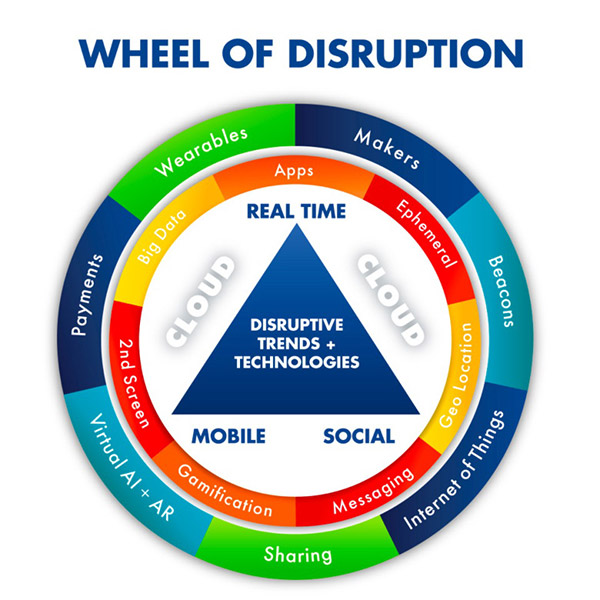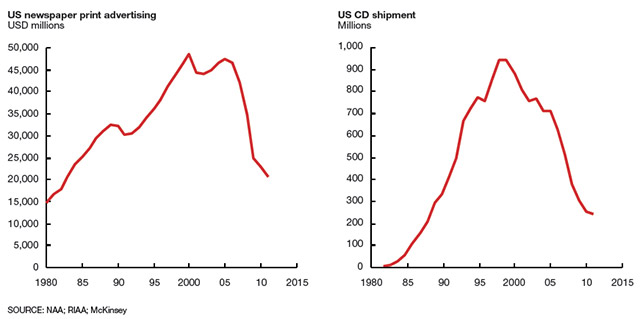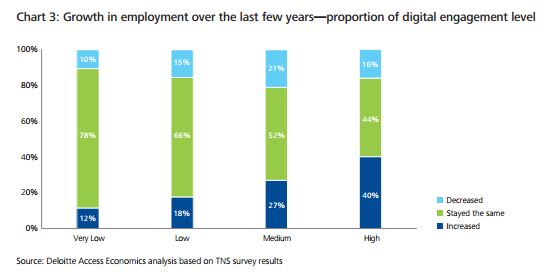A recent report into the benefits of high digital engagement is a must read for all South Australian small and medium sized business leaders.

South Australia Digital Disruption: Digital Opportunities, forecasts a veritable storm of digital disruption heading our way over the next three years, and explains how businesses can harness the opportunities it presents.
“We should all be concerned about the future because we will have to spend the rest of our lives there.” — Charles F. Kettering
The Age of Disruptive Technologies
In South Australia Digital Disruption: Digital Opportunities, Deloitte in collaboration with the Office of the Chief Information Officer, have compiled a report that’s sure to have elicited a broad spectrum of response from the business community. For those among us who are highly digitally engaged, the findings are reassuring. But for those who’ve failed to develop a digital presence via social media, search engine optimisation, content marketing, or the utilisation of cloud-based technologies; failed to recalibrate their cost structures in order to compete with digitally sophisticated, low-cost competition; and failed to replenish their revenue streams by building new sources online, this report is absolutely terrifying.
A host of disruptive technologies have converged in recent years to form what Brian Solis represents as the ‘wheel of disruption’. Solis states, “social, mobile, cloud, real-time, and everything around it, is not only affecting and shaping our way of life, it is changing how we work and do business… Disruptive tech does just that. It disrupts markets and introduces new direction and/or changes behavior. And thus, we enter an era of ‘Digital Darwinism’, a time when society and technology evolve.”
 Image credit: Brian Solis
Image credit: Brian Solis
The question that remains is: will your business adapt and survive? or refuse and perish?
Short Fuse, Big Bang
According to Deloitte, all industries, across all countries, will at some stage face a degree of digital disruption. However, for those of us living ‘down under’ the impact is tipped to be particularly pronounced, with 65% of the Australian economy based in industries expected to be facing a ‘big bang’ scenario over the next five years. For South Australia, this figure increases to 67%.
But what exactly does Deloitte mean by, ‘short fuse, big bang’?
“Businesses that stand to experience significant digital disruption within the next three years are said to be on a ‘short fuse’. Those that can expect major change in four to ten years are on a ‘long fuse’.The size of the impact, or ‘bang’, is described as the expected percentage change across a range of key business metrics. Businesses that can expect to see a fifteen to fifty per cent change in their revenue and expense metrics will experience a ‘big bang’. Below fifteen per cent, businesses will feel a smaller ‘bang’.”
With 430,000 South Australians, or sixty-four per cent of the workforce currently employed in a ‘big bang’ industry, there’s little doubt that digital disruption will have a major impact on the state’s economy in the coming years.
 Chart credit: South Australia Digital Disruption: Digital Opportunities – Deloitte Report
Chart credit: South Australia Digital Disruption: Digital Opportunities – Deloitte Report
The Need to Develop a Digital Presence
While its all too easy to view digital disruption as a threat, it is in fact, equal parts opportunity. It all boils down to the need for businesses, especially those in the ‘short fuse, big bang’ industries to establish a digital presence.
So which industries are set to be most affected?
- Information and Communications Technologies & Media
- Finance
- Retail
- Real Estate
- Professional Services
In order to avoid becoming a victim of digital darwinism, like many iconic companies such as Kodak, Blockbuster, Borders and Polaroid, South Australian businesses must begin to exploit the economic benefits of establishing a strong digital presence.
“Technology’s affect on society is slowly but surely disrupting business models that cannot keep up with more connected, nimble, and informed customers”, says Brian Solis in VentureBeat. “We know technology and society are developing. The question is whether or not businesses of today choose to adapt or merely die a slow death by a thousand digital cuts.”
 Chart credit: South Australia Digital Disruption: Digital Opportunities – Deloitte Report
Chart credit: South Australia Digital Disruption: Digital Opportunities – Deloitte Report
Here are four easy, and actionable ways you can lay the foundations for a high level of digital engagement:
1. Build a Website
The first and most obvious step in establishing a digital presence is to get on the web. And while this may seem like a no brainer, there are plenty of micro and small businesses out there operating without even the most basic of websites.
2. Use SEO
Optimise your site for search using search engine optimisation. Otherwise, you simply won’t get found After all, if you’re not on page 1 of Google you might as well not have a website. According to the US based search company, Chitika, 91.5% of searchers refuse to go beyond the first page of search results.
3. Get Social
Make sure you have a social media presence, especially if you’re in one of the ‘big bang’ industries. As Ewan Duncan and Eric Hazan note in their article, Digital Disruption: Six Consumer Trends, “Social networking represents almost a quarter of all Internet time (up 10 percentage points since 2008) and reaches over 75 percent of all Internet users.” However, it’s important to remember that social media shouldn’t be used as a direct selling tool. Instead, use it to understand your customers and engage with them. The art of social lies in fostering exchanges that deliver value back to your customers. As the new ‘word of mouth’, the aim is to support and grow brand advocates.
4. Go Mobile
With more than 70% of Australians now using smartphones, and more than 40% of them making purchases directly from it, according to Our Mobile Planet, you’re missing out on a huge slice of the pie if you’re in e-commerce and operating without a mobile friendly site.
The Benefits of Digital Engagement
In 2013 Google commissioned Deloitte to explore the direct economic benefits of digital engagement for SMEs. And lo and behold, the Connected Small and Medium Businesses report concluded that those organisations that embraced disruptive technologies significantly outperformed those that resisted. However, while this is relevant to all Australian SMEs, it is particularly important to South Australia; a state with more than 50,000 businesses with between 1-199 employees.
Small businesses with a high level of digital engagement are thriving. Of the businesses surveyed as part of the 2013 report, those classified as having a high level of digital engagement were four times more likely to have hired new staff in the past few years, and enjoyed a median revenue per employee that was more than double that of a business classified as having a low level of digital engagement.
 Chart credit: South Australia Digital Disruption: Digital Opportunities – Deloitte Report
Chart credit: South Australia Digital Disruption: Digital Opportunities – Deloitte Report
Besides these macro advantages, Deloitte’s recent reports highlight a host of other (more micro) benefits of digital engagement. These include, but are not limited to:
-
- Expanding the capacity to innovate: Online systems enhance an organisations’ ability to accelerate innovation internally, as well as helping SMEs to gain input from external experts across the world
- Reduce marketing costs: Digital technologies enable SMEs to reduce marketing and advertising expenses by allowing them to bypass traditional mass media avenues, by means of inbound marketing, social media, and SEO
- Exploit new geographies: The internet allows SMEs to sell and deliver goods and services well beyond traditional markets and geographies
- Gain access to new segments: The Internet and other digital innovations make it easier for SMEs to move into new product and customer segments. Whereas traditional retailers have been limited in their potential to reach niche customers, search engines and online advertising have made new segments more accessible
- Increase flexibility and worker mobility: Digital innovations such as smartphones, Skype and cloud computing, offer employers opportunities to improve staff retention by providing more flexible working arrangements for their employees
- Leverage cloud computing: Cloud computing and cloud-based services make IT more flexible, allowing users to store information, software and shared resources in data centres that are accessible from any location with internet access.Cloud services allow businesses to reduce their computing infrastructure, and in turn, the size of the teams required to manage it
- Reconsider transport and facilities: New approaches to moving and storing goods have evolved with the digital economy. Occupancy costs are also dramatically lower for ‘e tailers’ compared with traditional ‘bricks and mortar’ retailers
- Source globally: The sourcing of low-cost products from cheaper locations has been turbocharged by digital technologies
- Exploit location awareness: Location-based services (LBSs) use a set of computing capabilities to deliver content and functions that are specifically relevant to the user based on their current location. In context LBSs can be used to deliver functionality and content in a more relevant and useful format to consumers
Conclusion
Digital Disruption presents South Australian businesses with a simple, yet startling proposition: adapt or die.
By forging a strong digital presence and becoming digitally engaged, SMEs will not only adapt, but thrive in the coming decade. However, those businesses who refuse to adapt, will become victims of digital darwinism.
With almost two thirds of the state’s economy classified as working within ‘big bang’ industries, digital disruption is set to radically change our economy. You can either ignore Deloitte’s predictions, and adopt a business as usual approach, or embrace this digital future… the choice is yours.

Comments (0)